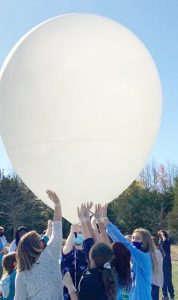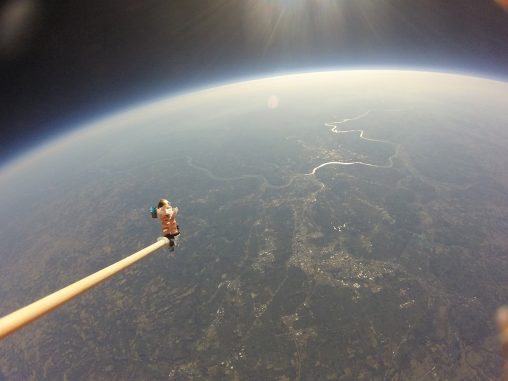
Wright State engineering students helped a STEM class at Valley View Junior High School to launch a high-altitude balloon.
A high-altitude balloon bearing middle school students’ experimental seeds soared nearly 16 miles above the Earth’s surface before returning to the ground thanks to four Wright State University engineering students.
The Wright State students, members of the Wright State chapter of the American Institute of Aeronautics and Astronautics, helped the seventh- and eighth-grade STEM class at Valley View Junior High School in Farmersville perform the experiment.
“They were the best team of engineering students to help me and my students plan and execute a high-altitude balloon launch,” said Valley View teacher Jill Weaver. “I cannot tell you how much it means to me to have had this help that they provided on their own time.”
The team included Hunter Gilliland, a mechanical engineering major from New Carlisle who serves as the chapter’s president and chair; Anna Spiros, a biomedical engineering student from Akron; Caleb Wasserbeck, a materials science and engineering major from Prospect; and Nathan Childs, a mechanical engineering student from Huber Heights.
The Wright State engineering students began meeting remotely with Weaver in September, planning the launch, gathering materials and making prediction models. Weaver shared their progress with her students as they conducted their seed experiments, studied the layers of the atmosphere and conducted research.
“The engineering team was so professional and spent countless hours on their own conducting research and making suggestions for our launch. We worked as a team to make sure that everything went without a hitch,” said Weaver. “I could not have had a better group of young professionals to help me bring this experience to my students.”
Along with a study of the Earth’s atmosphere, the middle school students came up with the idea of studying seeds in near space as a way to think about the future of space exploration and terraforming Mars for habitation.
Finally, on Nov. 6, conditions were right for launch. The middle school students had been assigned roles and on launch day were partnered with the Wright State students to watch and ask questions.
The balloon, 6.5 feet in diameter, was launched from the practice field behind Valley View Junior High, rocketing into the air when it was released. A total of about 150 people were on hand to watch the launch.
“The students were all very excited to be able to participate and watch this event,” said Weaver. “We launched with students and staff participating in the 10-second countdown.”
The balloon’s journey lasted two hours, traveled 33 miles, and was retrieved by the engineering students on the green of a golf course in Maineville near Kings Island. The balloon had reached a flight altitude of 83,927 feet, or 15.895 miles high, when it popped and floated back to Earth by parachute.
“I think the biggest thing we got out of this was fun and pride as a club,” said Gilliland. “It was a good learning experience with how to properly protect equipment at very high altitudes and how to legally and properly launch high-altitude balloons for an array of experiments.”
The middle school students plan to analyze the data they collected on temperature, pressure and altitude along with the seed study and cultivation of the flown seeds.
“We have a greenhouse set up in our classroom and students have been growing and analyzing the seeds,” said Weaver. “Now we will plant and cultivate our flown seeds that have been exposed to the elements of near space, including radiation, and compare them with our ground truth plants.”
Weaver said she is certain that the experience will be something her students will never forget. Additional launches are proposed for the spring.
“This is how we as teachers can generate interest in STEM careers along with creating a love for science, technology, engineering and math,” she said. “These students may not all go into STEM careers, but they can all participate in citizen science and have a voice in decision-making processes in their future communities and the world.”


 Bags, boards and bonding
Bags, boards and bonding  More than 1,000 students to graduate at Wright State’s fall commencement ceremonies
More than 1,000 students to graduate at Wright State’s fall commencement ceremonies  Wright State’s Take Flight Program helps students soar high
Wright State’s Take Flight Program helps students soar high  Wright State Police Department delivers major donation to Raider Food Pantry
Wright State Police Department delivers major donation to Raider Food Pantry  Wright State engineering and computer science students earn prestigious federal SMART Scholarships
Wright State engineering and computer science students earn prestigious federal SMART Scholarships 